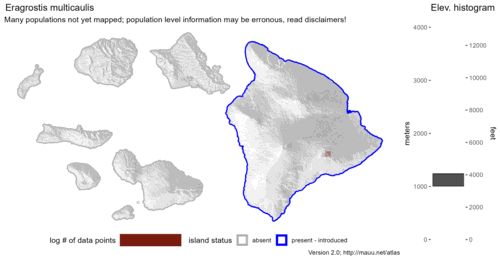Info
Subfamily: Chloridoideae
Genus etymology: Eragrostis = "love grass" [Greek] unclear origin, other etymologies such as "early grass" or "very grass" have also been speculated
Species etymology: multicaulis = "many stems" [Latin] refering to the growth form
Photosynthetic type: C4 (warm season)
Nativity: naturalized - accidental
First recorded in Hawaiʻi: 1943
Map

Inflorescence
 image credit: Shin-Ming_Ku
image credit: Shin-Ming_KuPlant
 image credit: 廖顯淳
image credit: 廖顯淳 image credit: Shin-Ming_Ku
image credit: Shin-Ming_KuSpikelets
 image credit: 廖顯淳
image credit: 廖顯淳Description
“Annual. Culms tufted, erect or ascending, geniculate at base. Leaf sheaths glabrous at summit or with a few short hairs, compressed; ligules a line of hairs, 0.2–0.1 mm; leaf blades usually flat, 3–9 cm × 0.5–2.5 mm, glabrous. Panicle open, 4.5–9 × 1.5–3 cm; branches solitary or in pairs but base branches nearly whorled, glabrous in axils; pedicels usually shorter than spikelets. Spikelets dark green, 2.5–4.5 mm, 3–10-flowered. Glumes membranous, falling off at maturity, lower glume narrow, veins obscure, ca. 0.6 mm, upper glume oblong-ovate, 1-veined, ca. 1 mm. Lemmas membranous, semi-ovate in side vein, ca. 1.5 mm, middle vein keeled, falling off at maturity. Palea membranous, ca. 1 mm, apex blunt, along 2 keels ciliolate, persistent or tardily falling off at maturity. Stamens 3; anthers ca. 0.2 mm. Caryopsis ca. 0.8 mm, striate. Fl. and fr. late summer. 2n = 40.
(Description source: Wu, Z.Y., Raven, P.H. & Hong, D.Y. (eds.). 2006. Flora of China. Volume 22. Poaceae. Missouri Botanical Garden Press, St. Louis. 733 pp. )